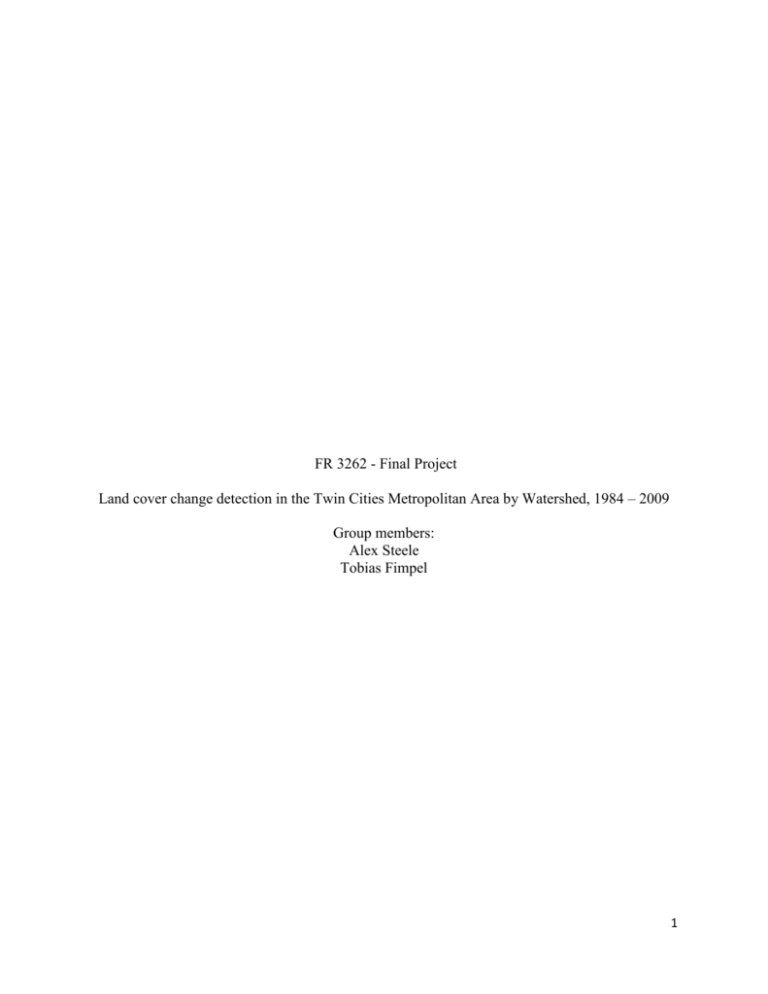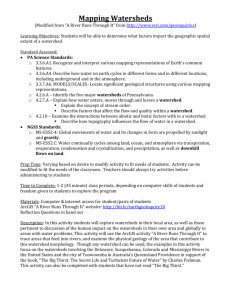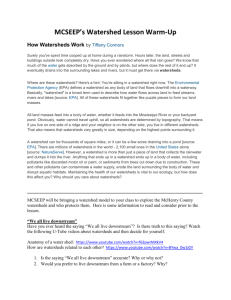Report
advertisement

FR 3262 - Final Project Land cover change detection in the Twin Cities Metropolitan Area by Watershed, 1984 – 2009 Group members: Alex Steele Tobias Fimpel 1 Objectives The aim of this project is to identify and quantify the land cover changes that have taken place over the past 25 years within the eight primary watersheds that the Twin Cities metropolitan area is part of. The rate of urban development in each watershed will be of particular interest. Urban development can have severe negative impacts on ecosystems by changing surface characteristics, which in turn affect the local water budget. When croplands or undeveloped areas are transformed into urban or suburban landscapes, the ability of fallen precipitation to permeate the surface and recharge soil moisture oftentimes decreases. Consequently the amount of surface runoff increases. When undeveloped lands are transformed into croplands, changes in the amounts of chemicals and sediments impact surface water conditions. Vegetative and hydrologic systems are thus directly affected by such land cover changes. A wealth of information about land cover conditions can be derived from remotely sensed data. Study Area and Data The study area is composed of seven adjoining counties located in south-eastern Minnesota: Anoka County (excluding a small portion in the northern part), Washington County, Hennepin County, Ramsey County, Carver County, Scott County, and Dakota County. In total, the study area covers approximately 3000 square miles and is home to a population of nearly three million people. Eight primary watersheds are part of the study area. These range from approximately 46 square miles to 1011 square miles in size. To delineate watershed boundaries we obtained the shapefile “Watersheds in the Twin Cities Metropolitan Area - DNR Level 08 Catchments” from the Metropolitan Council. 2 Land cover information was derived from two Landsat images, one taken on 08/15/1984, and one taken on 07/25/2009. Both are Landsat scenes located at Path 37, Row 29, taken by a Landsat TM sensor. The images are made up of a total of six bands with a spatial resolution of 30 meters and one band with a spatial resolution of 120 meters. The spectral resolution is as follows: Band 1 0.45μm-0.52μm, band 2 0.52μm-0.60μm, band 3 0.63μm-0.69μm, band 4 0.76μm-0.90μm, band 5 1.55μm-1.75μm, band 6 10.40μm-12.50μm, band 7 2.08μm-2.35μm. The image dating from 2009 we obtained from the United States Geological Survey’s website, the image dating from 1984 was provided to us by the course instructor and its bands were already stacked. Procedures The software used to perform the following procedures was ERDAS Imagine 2010. Before beginning the image classification process, we created a layer stack for the later image and visually inspected the Landsat scenes. Using the “Layer Selection and Stacking” function we stacked the .TIF Image files we obtained from the United States Geological Survey’s website, thereby creating an ERDAS .img file. After this step, the image dating from 8/15/1984 as well as the image dating from 07/25/2009 were processed very similarly. Close visual inspection of the two scenes showed no apparent radiometric or geometric errors, so that we proceeded to the image classification process. For the purpose of this study, we desired a classification scheme with the following four informational classes: water, undeveloped land, agriculture, and urban land. Water was to include wetlands and areas of open surface waters such as lakes and rivers. Undeveloped land was to include forests, grasslands, and brush. The agricultural class was to include areas used for growing crops. Areas occupied by streets and buildings made up the urban class. 3 After several failed attempts to devise an unsupervised pixel-based classification scheme that produces these four informational classes we decided to perform a supervised pixel-based classification on both images instead. Using Erads Imagine’s signature editor we created a signature file for each image. Because areas of barren fields showed fundamentally different radiometric properties than fields where crops were being grown, we created two spectral classes representing agriculture which we later merged. By creating two spectral classes, one for cultivated fields and one for barren fields, we avoided having one single spectral class representing agriculture with a very large variance which in turn may have led to the misclassification of grasslands as agricultural areas. In order to minimize negative effects of differing atmospheric conditions possibly present in different parts of each Landsat scene, we delineated all training sites (AOIs) within the extent of our study area in the northeastern portion of the two scenes. For the image dating from 1984 we delineated 20 AOIs for water, 27 AOIs for undeveloped lands, 15 AOIs for barren agricultural land, 30 AOIs for cultivated agricultural lands, and 27 AOIs for urban areas. We then merged signatures representing the same class. The resulting merged signature classes contained the following number of pixel: 38934 pixel for water, 14173 pixel for undeveloped lands, 2830 pixel for barren agricultural lands, 13349 pixel for cultivated agricultural lands, and 11651 pixel for urban areas. Next we ran the classification using the Maximum Likelihood classification algorithm and, following this, merged the two resulting informational classes representing agriculture using the thematic recode function. The image dating from 2009 was processed similarly. 4 Next we clipped the images to the study area’s extent via Erdas Imagine’s “Subset and Chip” operation. To do this we converted the shapefile containing the watershed boundaries into an Erdas Imagine Area of Interest file (.aoi) and used this file to define the extent of the “Subset and Chip” operation’s output. Before proceeding with the change detection step, we assessed the accuracy of each classified image subset. For the subset image dating from 1984 we used a stratified random sample of 120 points, weighted by area, with a minimum of 15 points per class. As reference data we used the same Landsat image that we used for the classifications. The accuracy assessment of the image dating from 1984 produced the following results (fig 1): Class Reference Classified Number Producers Users Totals Totals Correct Accuracy Accuracy ---------- ---------- ------- --------- ----- Urban 25 22 20 80.00% 90.91% Ag. 27 35 16 59.26% 45.71% Undev. 50 48 35 70.00% 72.92% Water 18 15 15 83.33% 100% Totals 120 120 86 Name ---------- Fig. 1: Accuracy Totals for Subset Image 1984 The overall classification accuracy was 71.67%, the overall Kappa statistic 0.6014. For the accuracy assessment of the subset image dating from 2009 our sample was made up of 20 randomly chosen points for each of the four classes. Also here, the same Landsat image that we used for the classification was used as reference data. The accuracy assessment of the image dating from 2009 produced the following results (fig 2): 5 Class Reference Classified Number Producers Users Totals Totals Correct Accuracy Accuracy ---------- ---------- ------- --------- ----- Undev 25 20 18 72.00% 90.00% Urban 20 20 17 85.00% 85.00% Ag 13 20 12 92.31% 60.00% Water 21 20 20 95.24% 100.00% Totals 80 80 67 Name ---------- Fig. 2: Accuracy Totals for Subset Image 2009 The overall classification accuracy was 83.75%, the overall Kappa statistic 0.7842. When both subset images were overlaid in one Erdas Imagine viewer, it became apparent that although the pixel boundaries of both images were geometrically identical, the Landsat scene dating from 2009 extended slightly further towards northwest than the one dating from 1984. This difference was noticeable because both Landsat scenes did not include a small part in the northern portion of Anoka County, which was part of the Area of Interest file delineating the watershed boundaries. To remedy this we used the “Mask” utility to crop the extent of the 2009 subset image to the very same extent as that of the 1985 subset image. To detect changes in the land cover between the two dates we used the “Matrix Union” utility to create a file containing a matrix of all “from-to” class change possibilities. This changemap provided land cover change information for the entire study area summarized by zone. Overlaying the .aoi file containing watershed boundaries that was created in an earlier step allowed us to generate eight image files, one for each primary watershed, via the “Subset and Chip” utility. The attribute tables of these eight image files contained “from-to” land cover change information pertaining to the respective individual watersheds. The values contained in 6 these attribute tables we then used in ArcGIS, Adobe Illustrator, and Microsoft Office Excel to generate maps, tables, and graphs presented in the following section. Results We were able to accomplish our objective, which was to identify and quantify the land cover changes that have taken place over the past 25 years within the eight primary watersheds of the Twin Cities metropolitan area. Tables about detailed land cover change information for each watershed can be found in the appendices. We found that the overall pattern of land cover change has been similar for all eight primary watersheds (fig 3). Fig. 3: Land Cover Change by Primary Watershed in Hectare, 1984-2009 Between 1984 and 2009 agricultural lands have largely been either converted to urban areas or have remained agricultural, all watersheds show very little conversion of agricultural lands into undeveloped areas. Undeveloped lands show a tendency of having been changed to agricultural and urban areas, with the exception of two watersheds, namely St. Croix-Stillwater 7 and Rum River, where more than half of the undeveloped areas from 1984 remained undeveloped in 2009. Urban areas have mostly remained Urban, but a significant amount of change from Urban to Agriculture was detected, too. Areas occupied by Water in 1984 largely remained Water in 2009 but some change from Water to Undeveloped and from Water to Urban was detected, too. As illustrated by the following maps, the two watersheds “North Fork-Crow River” and “Mississippi River Rush-Vermillion” saw the highest rates of urbanization at the expense of both undeveloped lands and agricultural lands. About 16% of the area contained within each of these watersheds has undergone a change from Agriculture to Urban, and about 20% of the area contained within each of these two watersheds has undergone a change from Undeveloped to Urban (fig 4, fig 5). Fig. 4: Agriculture to Urban by Watershed, 1984 - 2009 8 Fig. 5: Undeveloped to Urban by Watershed, 1984 - 2009 Since the overall accuracies of both classified subset images were moderately high (73% and 84%) our results are most likely reflective of the general trends and their magnitudes within individual watersheds. The values could be used to inform decisions of public planners and natural resource managers but are not sufficiently accurate to be used as data for further scientific studies, such as for example statistical analyses of land cover change effects on water quality. Discussion To construe more definite conclusions from the results of this project, a more comprehensive accuracy assessment would be necessary. The accuracy assessment that was carried out has several limitations. Firstly, the number of points sampled was insufficient. Secondly, reference data that is better interpretable than Landsat scenes should be used instead. 9 Thirdly, our samples used were biased in that not every pixel had the same chance of being selected. The performance of the classification process could be greatly enhanced by the inclusion of additional data. Multi seasonal Landsat images would help to differentiate undeveloped lands from croplands that are tilled during spring or fall. Furthermore, it would accentuate differences in the radiometric responses of urban areas and agricultural lands. Including multispectral data from early spring or late fall would most likely have also been beneficial for discerning undeveloped lands from wetland areas. Considering the very simple classification system made up of only four classes, the acquisition of costly high-resolution imagery would certainly not be justified. Appendices From-To Change Area (Hectacres) Percent Change Ag to Ag 107498 14.06525263 Ag to Undev 23728.5 3.104684245 Ag to Urban 109680 14.35074986 Ag to Water 4619.52 0.604427206 Undev to Ag 166119 21.73534114 Undev to Undev 73038.9 9.556555287 Undev to Urban 128269 16.78297168 Undev to Water 8607.78 1.126259096 Urban to Ag 14378.2 1.881272353 Urban to Undev 2544.57 0.332936612 Urban to Urban 90376.5 11.82504144 Urban to Water 3196.89 0.418287461 Water to Ag 3762.81 0.492333562 Water to Undev 4485.15 0.586845968 Water to Urban 6627.6 0.867168397 Water to Water 17348.2 2.269873074 Total 764280.62 100 Fig. 6: Land Cover Change 1984-2009, Entire Study Area 10 From-To Change Area (Hectacres) Percent Change Ag to Ag 11598.8 29.47531809 Ag to Undev 651.24 1.654956216 Ag to Urban 4200.93 10.67556541 Ag to Water 98.64 0.250667774 Undev to Ag 15465.2 39.30076296 Undev to Undev 1312.2 3.334613271 Undev to Urban 5351.13 13.59849803 Undev to Water 84.42 0.214531361 Urban to Ag 204.03 0.518488908 Urban to Undev 22.41 0.056949157 Urban to Urban 139.14 0.353587937 Urban to Water 3.78 0.009605882 Water to Ag 32.49 0.082564842 Water to Undev 21.42 0.05443333 Water to Urban 23.22 0.05900756 Water to Water 141.84 0.360449281 Total 39350.89 100 Fig. 7: Land cover Change1984-2009, Cannon River Watershed From-To Change Area (Hectacres) Percent Change Ag to Ag 34803.1 17.44287479 Ag to Undev 4799.34 2.405368679 Ag to Urban 30061.8 15.06659502 Ag to Water 1467.72 0.735602753 Undev to Ag 49313.6 24.71535438 Undev to Undev 10815.9 5.420792671 Undev to Urban 34805.7 17.44417787 Undev to Water 2281.86 1.143639453 Urban to Ag 3457.44 1.732825323 Urban to Undev 543.51 0.272400357 Urban to Urban 20689.9 10.36951694 Urban to Water 637.56 0.319537031 Water to Ag 485.46 0.243306429 Water to Undev 980.82 0.491574614 Water to Urban 1350 0.676602974 Water to Water 3032.46 1.519830707 Total 199526.17 100 Fig. 8: Land cover Change1984-2009, MN River-Shakopee Watershed 11 From-To Change Ag to Ag Ag to Undev Ag to Urban Ag to Water Undev to Ag Undev to Undev Undev to Urban Undev to Water Urban to Ag Urban to Undev Urban to Urban Urban to Water Water to Ag Water to Undev Water to Urban Water to Water Total Area (Hectacres) 19453.1 1014.03 14063.6 108.63 24758.8 3143.61 16420.82 206.82 1442.7 76.23 3553.92 36.99 86.94 112.41 169.11 104.49 84752.2 Percent Change 22.9529145 1.196464517 16.59378754 0.128173664 29.21316497 3.709178051 19.37509587 0.244029064 1.702256697 0.089944568 4.193307076 0.043644885 0.102581408 0.132633725 0.199534643 0.123288835 100 Fig. 9: Land cover Change1984-2009, Mississippi River Rush-Vermillion Watershed From-To Change Area (Hectacres) Percent Change Ag to Ag 20082.1 7.669173616 Ag to Undev 5188.05 1.981269697 Ag to Urban 41470.1 15.83705871 Ag to Water 1855.35 0.708541501 Undev to Ag 37283 14.23804283 Undev to Undev 18670.9 7.130249011 Undev to Urban 42393.7 16.18977326 Undev to Water 3923.73 1.498437245 Urban to Ag 7788.51 2.974362014 Urban to Undev 1020.15 0.389586122 Urban to Urban 62681.8 23.93761642 Urban to Water 2335.05 0.891734622 Water to Ag 1531.89 0.585015032 Water to Undev 2225.97 0.85007795 Water to Urban 3844.26 1.468088365 Water to Water 9560.25 3.650973606 Total 261854.81 Fig. 10: Land cover Change1984-2009, Mississippi River Twin Cities Watershed 100 12 From-To Change Percent Change Ag to Ag Area (Hectacres) 3860.37 Ag to Undev 4608.45 10.75079054 Ag to Urban 6800.67 15.86489573 Ag to Water 110.97 0.258875593 Undev to Ag 5220.18 12.17786062 Undev to Undev 12217.1 28.5005768 Undev to Urban 7263.54 16.94469879 Undev to Water 191.16 0.445946277 Urban to Ag 381.78 0.890632819 Urban to Undev 419.76 0.979234198 Urban to Urban 1183.77 2.761549614 Urban to Water 17.82 0.041571263 Water to Ag 227.34 0.530348538 Water to Undev 56.07 0.13080251 Water to Urban 68.49 0.15977642 Water to Water 238.68 0.556802979 Total 42866.15 Fig. 11: Land cover Change1984-2009, Rum River Watershed 9.005637315 100 From-To Change Area (Hectacres) Percent Change Ag to Ag 7875.54 9.495191844 Ag to Undev 4567.86 5.507267694 Ag to Urban 7439.22 8.96914003 Ag to Water 600.39 0.72386379 Undev to Ag 17643.9 21.27247343 Undev to Undev 20937 25.24281911 Undev to Urban 13318.7 16.05777021 Undev to Water 1284.3 1.548423967 Urban to Ag 702.9 0.847455584 Urban to Undev 335.97 0.405064237 Urban to Urban 1735.11 2.091945736 Urban to Water 138.42 0.1668869 Water to Ag 1118.79 1.348875846 Water to Undev 781.02 0.941641428 Water to Urban 978.21 1.17938473 Water to Water 3485.07 4.201795463 Total 82942.4 100 Fig. 12: Land cover Change1984-2009, St. Croix-Stillwater Watershed 13 From-To Change Area (Hectacres) Percent Change Ag to Ag 1963.35 16.46104509 Ag to Undev 669.87 5.616298812 Ag to Urban 1908.09 15.99773628 Ag to Water 94.59 0.793057914 Undev to Ag 2861.28 23.98943596 Undev to Undev 1179 9.884927372 Undev to Urban 2431.8 20.38860592 Undev to Water 108.18 0.906998679 Urban to Ag 126.36 1.05942275 Urban to Undev 49.14 0.411997736 Urban to Urban 231.57 1.941520468 Urban to Water 8.55 0.071684588 Water to Ag 40.59 0.340313148 Water to Undev 80.37 0.673835125 Water to Urban 64.98 0.544802867 Water to Water 109.53 0.918317299 Total 11927.25 100 Fig. 13: Land cover Change1984-2009, North Fork-Crow River Watershed From-To Change Area (Hectacres) Percent Change Ag to Ag 8127.81 18.90767035 Ag to Undev 2262.33 5.262843233 Ag to Urban 4110.57 9.562391653 Ag to Water 282.87 0.6580386 Undev to Ag 13994.6 32.55554491 Undev to Undev 4872.96 11.33593444 Undev to Urban 6775.47 15.7617308 Undev to Water 527.67 1.227515212 Urban to Ag 301.05 0.700330613 Urban to Undev 79.92 0.185917364 Urban to Urban 318.15 0.740110229 Urban to Water 18.45 0.042920112 Water to Ag 251.55 0.585179092 Water to Undev 238.32 0.554402231 Water to Urban 149.04 0.346710761 Water to Water 676.08 1.572760408 Total 42986.84 100 Fig. 14: Land cover Change1984-2009, South Fork-Crow River Watershed 14







